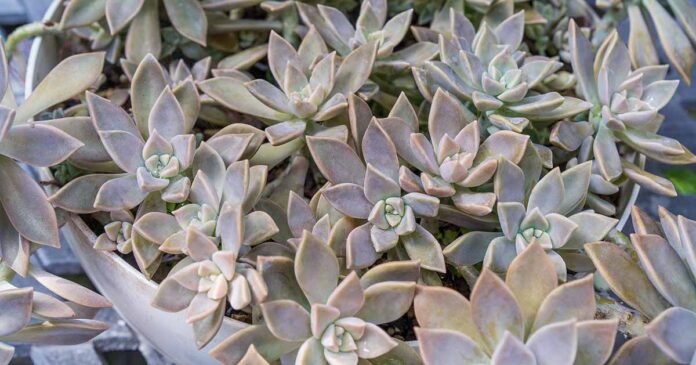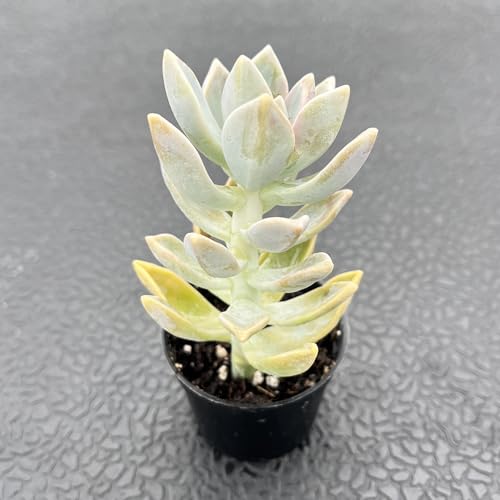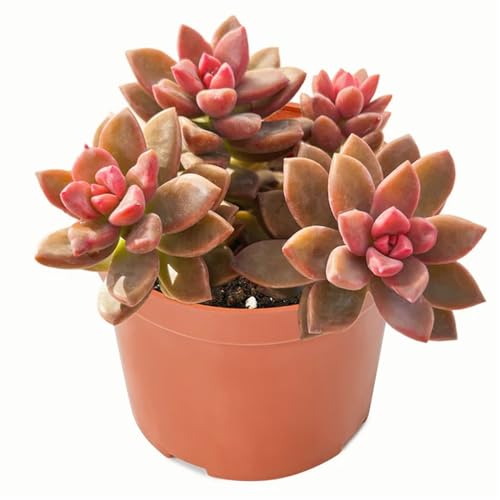Soil
Outdoor in-ground ghost plants require well-draining, sandy loam with a pH of 6.1 to 7.8.
If you’re using containers, make sure they have one or more drainage holes and use a cactus and succulent potting mix, or follow these instructions to make your own.
Loose, lean soil facilitates drainage and reduces the risk of rotting.
Water
Ghost plants store moisture in their leaves and have excellent drought tolerance. When established, those growing in the garden won’t need water unless there is a lengthy drought.
Allow the soil in containers to dry out completely before watering. You can use a moisture meter to guide you.
If you live in a community with municipal water, you may find that mineral salts build up on the soil and sides of containers.
Remedy the situation by watering with purified or distilled water. You can find more information about watering succulents here.
Fertilizer
It’s not necessary to fertilize ghost plants. If you choose to do so, wait until they are at least a year old to avoid burning the developing roots.
Use a liquid product formulated for cacti and succulents diluted to a quarter or half strength in early spring. It should be low in nitrogen to avoid producing fast growth that results in spindly stems.
If you need a recommendation, I use Miracle-Gro Succulent Plant Food.
Miracle-Gro Succulent Plant Food
This product has an NPK ratio of 0.5-1-1, making it very low in nitrogen and mild.
You can find Miracle-Grow Succulent Plant Food available via Amazon.
Our guide to fertilizing succulents has more information.
Cultivars to Select
When shopping, you’ll find various options available, though often they will just be listed as “ghost plant” or “mother of pearl.”
The straight species has the typical whitish-gray-green foliage and white flowers with red accents.
You can find the species in two-inch pots available from Sprout N Green via Amazon.
Bronze
G. paraguayense cv. bronze, sometimes listed as ‘Bronze’ has brightly hued foliage that shade orange and red with ample sun exposure, but green in low light conditions.
The star-shaped flowers are yellow.
This cultivated variety contrasts sharply with green succulents for a bold mixed grouping.
You can find specimens in four-inch pots available from The Next Gardener via Amazon.
Purple Haze
‘Purple Haze’ is a hybrid of G. paraguayense and G. superbum, a pink-to-lavender species with yellow flowers. It has gray-to-lavender foliage and classic white flowers with red flecks.
Pair it with the species for a complementary pastel lavender and pearlescent gray-green display.
Variegated
The naturally occurring variegated form of the species, G. paraguayense f. variegatum, has white, purple/pink, and gray-green foliage.
The white flowers are speckled with red, crowning the eye-catching foliage.
Outstanding as a standalone specimen, this option requires a full-sun placement for optimal leaf variegation.
Variegated ghosts are available from DH7 Enterprise via Amazon.
Maintenance
Ghost plants require little maintenance when their basic cultural requirements are met.
As the lowest leaves age, they turn yellow. You can gently twist them off to keep the rosettes tidy and encourage new growth.


Remove any foliage damaged by pathogens or pests to reduce susceptibility to further problems.
After flowering, trim flower stems to their base to tidy up.
Repot container-grown ghost plants when roots start to emerge from the drainage holes, moving them into a pot just one size larger.






